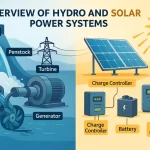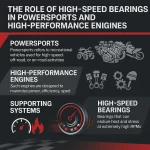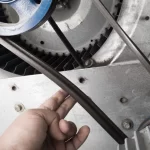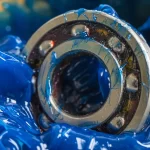Steel bearings, known as white etching cracks (WEC), are susceptible to deterioration. WECs are distinguished by the development of white, needle-like cracks on the bearing raceway’s surface. These fractures are linked to early bearing failure and often occur in high-stress locations.
To understand this, let’s learn about rolling contact failure.
Reasons for white Etching Cracks In Bearings
Bearing rolling contact failures can be caused by several things, including material flaws, lubrication problems, overloading, contamination, and poor handling or installation. Following are some of the most typical bearing rolling contact failures:- Fatigue failure: The most frequent rolling contact failure is fatigue failure. It happens due to the bearing being loaded and unloaded repeatedly in cycles, which can lead to material fatigue and the development of cracks. These fissures have the potential to spread over time and cause the bearing to fail severely.
- Wear: Metal-to-metal contact between the rolling elements and the raceway can cause wear, resulting in material loss and modifications to the bearing geometry. This can result in more friction and worse bearing performance.
- Corrosion: Corrosion is a condition that can be brought on by exposure to chemicals, moisture, or other environmental elements. It may result in surface flaking or pitting, which could eventually cause the bearing to fail due to localized stress concentrations.
- Brinelling: Brinelling is an indentation failure that happens when a bearing is exposed to heavy static loads, including during installation or transportation. Localized stress concentrations brought on by the indentation may eventually result in fatigue failure.
- Spalling: Spalling is the separation of tiny flakes or particles of material from a bearing’s surface. It could be brought on by poor lubrication, overloading, or material flaws. Increased friction, vibration, and eventual bearing failure can result from spalling.
- Fretting: Fretting is a type of wear brought on by oscillations of modest amplitude between the rolling components and the raceway. Particularly in parts of the bearing that experience significant stress, it can result in surface damage and fatigue failure.
Rolling contact fatigue and its type
A frequent type of damage to bearings caused by repeated cyclic loading and unloading is rolling contact fatigue (RCF). The three primary RCF subtypes are as follows:- Subsurface Initiated Fatigue: Cracks that begin below the surface of the bearing material, often at the most significant shear stress plane, are known as subsurface started to fatigue, a kind of RCF. Growing and eventually reaching the surface, the fissures result in pitting or spalling. Subsurface-initiated fatigue may result from overburden, insufficient lubrication, or flaws in the material.
- Surface-initiated fatigue: This kind of RCF develops when surface pressures or surface flaws cause cracks to start at or very close to the surface of the bearing material. Pitting or spalling results from the cracks as they deepen and pierce the surface. Inadequate lubrication, contamination, or material flaws can contribute to surface-initiated fatigue.
- White etching cracks: Subsurface and surface-initiated fatigue are governed by the classical ISO 281; ISO 16281; ISO 15243, whereas white etching crackas are not covered in ISO 281; ISO 16281; ISO 15243.
What Are White Etching Crack Failures?
Rolling contact fatigue (RCF) failures, such as white etching cracks (WECs), can occur in bearings. White, non-metallic material is often found in WECs, which is thought to result from localized heating and quick cooling during the crack’s creation. WECs usually start below the bearing material’s surface and gradually spread to the top. They may pit or spall the bearing surface if left unattended and cause catastrophic failure. Although the precise mechanisms that cause WECs to form are not entirely known, a combination of material characteristics, loading circumstances, and environmental factors have a role. High cyclic loads, insufficient lubrication, high operating temperatures, and material flaws are a few potential causes of WECs. WECs can be challenging to find because they are frequently invisible to the unaided eye. WECs can be located using non-destructive testing methods, including X-ray diffraction, eddy current testing, or ultrasonic inspection. Choosing the right materials, designing the bearing system to reduce stress concentrations, and providing enough lubrication and maintenance to prevent WECs. Frequent observation and examination can also aid in the early detection of WECs, enabling prompt repair or replacement of the harmed bearings.Solutions to overcome the white etching cracks
White etching cracks (WECs) in bearings must be rectified using a multifaceted strategy that considers the issue’s underlying causes. Here are a few potential answers:- Proper material selection: To prevent WECs, it is essential to use the appropriate bearing material. The risk can be decreased by using high-quality bearing materials for long loads and long life. Choosing materials that won’t corrode or wear out quickly is also crucial.
- Improved lubrication: To avoid WECs, adequate lubrication is essential. The creation of WECs can be avoided by using the proper type and quantity of lubricant to help decrease friction and wear in the bearing. Choose a lubricant intended for a particular purpose, and apply it at the proper intervals.
- Improved operating conditions: Temperature, speed, and load are only a few operating parameters that can influence the creation of WECs. WECs can be avoided by lowering operational temperatures and loads. To reduce stress concentrations, the bearing must be placed and aligned correctly.
- Non-destructive testing: WECs can be found before they cause catastrophic failures using non-destructive testing methods such as X-ray diffraction, eddy current testing, and ultrasonic examination. Frequent bearing monitoring and inspection can aid in the early detection of WECs and enable prompt repair or replacement of the harmed bearings.
- Design improvements: To lower the risk of WECs, the bearing system’s design can also be modified. This can involve modifications to the bearing’s size or form and advancements in mounting and alignment.
White etching cracks applications
Although they can develop in various rolling element bearings used in several applications, white etching cracks (WECs) are most frequently observed in industrial applications like wind turbines, rail transportation, and heavy machinery. WECs have been noted in several specific applications, including the following:- Wind turbine bearings
- Railway bearings
- Heavy machinery
- Automotive application
- Aerospace applications
- Hydrogen environment bearing
- CVT
- Paper and crusher mill



















